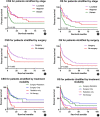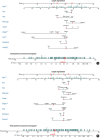A Clinical Model of Bone Angiosarcoma Patients: A Population-based Analysis of Epidemiology, Prognosis, and Treatment
- PMID: 32914587
- PMCID: PMC7767680
- DOI: 10.1111/os.12803
A Clinical Model of Bone Angiosarcoma Patients: A Population-based Analysis of Epidemiology, Prognosis, and Treatment
Abstract
Objective: To investigate the epidemiological data, prognostic factors, and treatment outcomes of bone angiosarcoma (BA).
Methods: This retrospective study was based on the Surveillance, Epidemiology, and End Results (SEER) database. The medical records of BA patients were selected from the SEER database from 1975 to 2016. Variables including patients' baseline demographics (age, sex, marital status, and year of diagnosis), tumor characteristics (tumor size, grade, and SEER Historic Stage A), and treatment (surgery and radiotherapy) were selected for further analysis. The research endpoints were overall survival (OS) and cancer-specific survival (CSS). The optimal cutoff values of continuous variables including age, year of diagnosis, and tumor size were identified using the X-tail program. Univariate Cox regression was used to identify potential prognostic factors and multivariate Cox regression was used to identify independent prognostic factors. All prognostic factors were included to predict the survival time compared to the median OS and CSS times via the novel nomograms. To validate the internal validation of nomograms, we analyzed the concordance indices (C-index).
Results: This study enrolled a total of 271 patients with malignant vascular bone tumors among residents of the United States between 1975 and 2016. After applying the exclusion criteria (one case without active follow-up), this study included 152 patients with BA. The median survival time of BA was significantly shorter than that of malignant vascular bone tumors for OS (9 months vs 27 months, P < 0.001). Age, year of diagnosis, tumor size, grade, stage, and surgery were identified as potential prognostic factors for OS or CSS in univariate Cox regression. However, only age (P < 0.001, P < 0.001), stage (P = 0.002, P < 0.001), and surgery (P = 0.001, P = 0.002) were independent prognostic factors for CSS and OS, respectively, in the multivariate analysis. Younger patients less than 54 years have significantly better prognosis for CSS/OS than patients between 54 and 67 years (Hazard ratios [HRs]: 1.651 [1.763-3.575], 2.557 [1.395-4.687]) and more than 67 years (HRs: 4.404 [2.237-8.670], 5.113 [2.923-8.942]). For CSS/OS, the survival time of patients with localized stage was significantly longer than that of patients with regional stage (HRs: 1.530 [0.725-3.228], 1.548 [0.834-2.873]) and that of patients with distant stage (HRs: 1.706 [0.899-3.237], 2.101 [1.254-3.520]). Patients with surgery had more survival time than patients without surgery for CSS/OS (HRs: 2.861 [1.542-5.310], 2.103 [1.308-3.379]). All factors were further included to generate nomograms for CSS and OS. The C-indexes for the internal validation of OS and CSS prediction were 0.787 (95% confidence interval [CI]: 0.738-0.836) and 0.768 (95% CI: 0.717-0.819), respectively.
Conclusions: Age, stage, and surgery were closely associated with prognosis in patients with BA, and this clinical model was a favorable tool to evaluate survival possibilities.
Keywords: Bone angiosarcoma; Model; Nomogram; Prognosis; Surgery.
© 2020 The Authors. Orthopaedic Surgery published by Chinese Orthopaedic Association and John Wiley & Sons Australia, Ltd.
Figures





Similar articles
-
Identifying the Prognosis Factors and Predicting the Survival Probability in Patients with Non-Metastatic Chondrosarcoma from the SEER Database.Orthop Surg. 2019 Oct;11(5):801-810. doi: 10.1111/os.12521. Orthop Surg. 2019. PMID: 31663279 Free PMC article.
-
Prognostic nomograms and Aggtrmmns scoring system for predicting overall survival and cancer-specific survival of patients with kidney cancer.Cancer Med. 2020 Apr;9(8):2710-2722. doi: 10.1002/cam4.2916. Epub 2020 Feb 22. Cancer Med. 2020. PMID: 32087609 Free PMC article.
-
Establishment and validation of systematic prognostic nomograms in patients over 60 years of age with osteosarcoma: A multicenter external verification study.Cancer Med. 2023 Apr;12(8):9589-9603. doi: 10.1002/cam4.5736. Epub 2023 Mar 29. Cancer Med. 2023. PMID: 36992547 Free PMC article.
-
Analysis of prognostic factors of metastatic endometrial cancer based on surveillance, epidemiology, and end results database.Front Surg. 2023 Jan 6;9:1001791. doi: 10.3389/fsurg.2022.1001791. eCollection 2022. Front Surg. 2023. PMID: 36684133 Free PMC article. Review.
-
Characteristics and outcomes of primary pleural angiosarcoma: A retrospective study of 43 published cases.Medicine (Baltimore). 2022 Feb 11;101(6):e28785. doi: 10.1097/MD.0000000000028785. Medicine (Baltimore). 2022. PMID: 35147108 Free PMC article. Review.
Cited by
-
Case Report: A rare case of multicentric angiosarcomas of bone mimicking multiple myeloma on 18F-FDG PET/CT.Front Med (Lausanne). 2023 Nov 28;10:1330341. doi: 10.3389/fmed.2023.1330341. eCollection 2023. Front Med (Lausanne). 2023. PMID: 38089865 Free PMC article.
-
Prognostic nomograms for predicting overall survival and cancer-specific survival in patients with angiosarcoma, a SEER population-based study.Sci Rep. 2022 Mar 3;12(1):3479. doi: 10.1038/s41598-022-07444-5. Sci Rep. 2022. PMID: 35241714 Free PMC article.
-
Personalized Surgical Planning for Soft Tissue Sarcoma of the Popliteal Fossa with a Novel 3D Imaging Technique.Orthop Surg. 2022 Nov;14(11):3028-3035. doi: 10.1111/os.13499. Epub 2022 Sep 21. Orthop Surg. 2022. PMID: 36128857 Free PMC article.
-
Right Thigh Mass Metastasis from Lung Cancer Mimicking Primary Soft Tissue Sarcoma: A Case Report.Am J Case Rep. 2024 Mar 2;25:e942416. doi: 10.12659/AJCR.942416. Am J Case Rep. 2024. PMID: 38429923 Free PMC article.
-
Angiosarcoma in the femoral bone: A case report of a rare bone tumor.Int J Surg Case Rep. 2024 Sep;122:110124. doi: 10.1016/j.ijscr.2024.110124. Epub 2024 Aug 13. Int J Surg Case Rep. 2024. PMID: 39142183 Free PMC article.
References
-
- Scholsem M, Raket D, Flandroy P, Sciot R, Deprez M. Primary temporal bone angiosarcoma: a case report. J Neurooncol, 2005, 75: 121–125. - PubMed
-
- Fedok FG, Levin RJ, Maloney ME, Tipirneni K. Angiosarcoma: current review. Am J Otolaryngol, 1999, 20: 223–231. - PubMed
-
- Conic RRZ, Damiani G, Frigerio A, et al Incidence and outcomes of cutaneous angiosarcoma: a SEER population‐based study. J Am Acad Dermatol, 2019, S0190‐9622: 32382–32385. - PubMed
-
- Boriani S, Cecchinato R, Righi A, et al Primary vascular bone tumors in the spine: a challenge for pathologists and spine oncology surgeons. Eur Spine J, 2019, 28: 1502–1511. - PubMed
-
- Fury MG, Antonescu CR, Van Zee KJ, Brennan MF, Maki RG. A 14‐year retrospective review of angiosarcoma: clinical characteristics, prognostic factors, and treatment outcomes with surgery and chemotherapy. Cancer J, 2005, 11: 241–247. - PubMed
MeSH terms
Grants and funding
LinkOut - more resources
Full Text Sources
Medical

